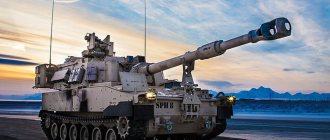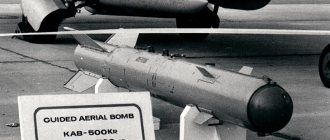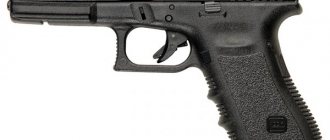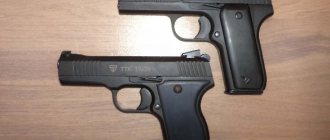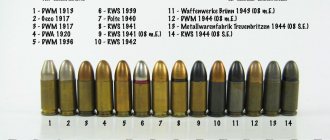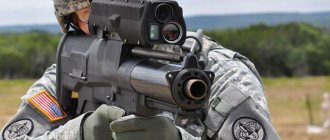Configurations
As stated earlier, transformation into a guided or glide bomb is quite simple with the current level of technology. You take a standard free-fall aircraft bomb and attach several gliding elements to it using removable clamps and bolts, but judging by even a few photographs from this article, there are essentially two ways to do this, especially when it comes to the moving control surfaces required for keeping the bomb on the required trajectory.
Control surfaces can be mounted in the nose, bow-rudder style, or more traditionally in the tail. The latter solution is suitable primarily for larger and heavier bombs, but requires, as can be seen in some photographs, the installation of protected (including physically) data transmission channels running along the body of the bomb and connecting the nose sensor unit with the rear moving ones surfaces.
Strangely enough, the scheme with nose rudders was implemented on a veteran among the gliding bombs of the modern era - the Paveway heavy laser-guided bomb, originally developed by Texas Instruments, which was used by the US Air Force in the 60s in Vietnam. Known among the troops under the designation GBU-1 (GBU - guided bomb unit), the Paveway laser-guided aerial bomb (later retroactively designated Paveway 1) looked rather clumsy, since it was based on a somewhat “thick” and without much a nod to the aerodynamics of the 750-pound M117 bomb. But at that time there was only one goal - to increase the accuracy of the bomb.
After the first Paveway model, the development and production of which was transferred to Raytheon and Lockheed Martin (partially), countless types and modifications followed, especially based on the Mk84 and Mk82 bombs, respectively weighing 2,000 and 500 lb (900 kg and 227 kg).
High explosive bomb Mk 84 (BLU-117/B) weighing 900 kg with a JDAM kit was designated GBU-31 JDAM
The Europeans developed their own kit for aerial bombs, designated PGM (precision guided munition). The very first designs were developed by the Italian company GEC Marconi, which later became Alenia Marconi, which eventually merged into what is known today as MBDA. A 500-pound bomb with a PGM kit has fairly smooth contours, since the nose and rear of it have a fairly large diameter and, when installed, form a single body around the bomb.
For a 2,000 lb bomb, this kit leaves the main body uncovered. However, only a smaller kit was mass-produced, which was sold to the United Arab Emirates (at that time the only weapon of this type of non-American origin) under the designation Hakim for installation on the Mirage 2000-9 fighters of that country's air force.
Guided bombs PGM 500 (top) and PGM 2000
The name of this Diamond Back kit, created by MBDA, is self-explanatory. The Diamond Back kit (in the picture with the wings spread) can be installed on virtually any guided bomb with the sole purpose of significantly increasing its gliding properties
New systems later emerged with longer range and greater accuracy, but this time by adopting sets of wings positioned approximately above the bomb's center of gravity to provide additional lift, something that even the large projecting X-shaped tail rudders of late Paveway bomb models could not offer. . The final solution came in the form of folding wings that deployed into a flight configuration once the bomb was a safe distance from the aircraft.
An example of such a design that immediately comes to mind is the Diamond Back kit from MBDA, which can be attached with clamps to existing Paveway-type bombs with an installed guidance kit: a sensor unit and cross-shaped control surfaces located immediately behind it. The Back Diamond kit provides lift to increase the bomb's range by 20 times.
However, long before the advent of clamp-on kits, Kentron, a division of Denel, apparently paved the way for glide bomb technology in its current form. Development of the Raptor system began in the 70s and upon its completion it entered service with the Mirage F1 fighters of the South African Air Force, which at that time was fighting with Angola. Unlike the Diamond Back, the Raptor kit's drop-down wings were attached to the bottom of the bomb, and a small propeller in the tail powered the bomb's electronics so as not to be dependent on the carrier aircraft's power grid. As for the bombs equipped with the Diamond kit, they turn over after the wings open.
The Raptor kit (retroactively named Raptor 1 when Raptor 2 was already planned) was the first example of a glide bomb. Initially it was controlled by radio commands, but later received a television seeker. According to South African pilots, it was sensitive to solar glare and could only be used to a limited extent when the sun was above the horizon. Most likely, the Raptor 2 variant did not progress beyond the development stage (photo below)
Boeing's small diameter SDB bomb, equipped with the Diamond Back kit, will hit the target in an instant. Diamond Back is also used along with the Jdam kit, later developed into the Jdam-ER variant
The Raptor II kit, which was intended to include a pair of parallel jet engines mounted under the wing assembly, was never fully developed. Instead, Denel developed the Umbani kit and showed it at the Africa and Aerospace Defense 2004 exhibition. It made its first flight on the Mk82 bomb from a Hawk fighter in 2011. According to the company, at that time she flew 40 km. Despite the company's commissioned pictures showing the drop of a bomb with this kit from a South African Gripen aircraft, this system will not be implemented in the near future, since huge investments are required to certify its use from a supersonic aircraft. However, everything may change with the certification of the Al Tariq kit developed by Tawazun Dynamics. It is worth noting that, nevertheless, the South African Air Force purchased Paveway IV bombs to arm its Gripen fighters.
In order to increase the range of the existing Spice series guided bombs, Rafael also developed a set of wings mounted under the fuselage.
Rafael developed the Spice 1000 kit, which is attached to the Mk83 bomb. The bomb, equipped with folding wings at the bottom of the fuselage, has a flight range of up to 60 km. Equipped with a dual guidance system (CCD and infrared camera at the final trajectory), the bomb recognizes its targets using a system for comparing reference and real terrain displays. Rafael claims a circular deviation of three meters
If there is no need for extreme ranges, then Boeing's offering of the GPS-guided Jdam kit is probably a good deal at around $20,000, which is about five times cheaper than its laser-guided counterparts. Typically, it allows for a maximum range of 30 km and a typical accuracy of about 10 meters. After transmitting the target coordinates to the system, the bomb is ready to be dropped
The matter is simplified when a simple GPS receiver or inertial measurement unit is used, because in this case there is no need for a complex sensor module in the nose. In this case, only a tail block with movable stabilizing surfaces is sufficient, such as the Jdam (Joint Direct Attack Munition) equipment kit from Boeing, which transforms existing free-fall bombs into all-weather spotting bombs. This system is a set of wings mounted in the middle part of the bomb and a tail block with a tail unit. It was originally developed by McDonnell Douglas and first used in Kosovo in the late 90s. Since then the kit has been sold to 26 countries.
Good ideas are often adopted by others, especially when they are simple. This is what happened with the Turkish HGK high-precision guidance kit, developed by the Defense Industry Research Institute of the Turkish Scientific and Technical Research Council Tubitak Sage. This kit actually replicates the Jdam retractable design used as aerodynamic stabilizers. According to the manufacturer, this kit provides a circular probable deviation of only 10 meters for the Mk82 bomb with an inertial navigation system, and only 6 meters when GPS is activated. When dropped from a high altitude, the range is about 30 km. The Jdam kit, for its part, is attached to the 2000 lb Mk84 bomb and the 1000 lb Mk3.
At Tariq kit at the Tawazun stand at the Dubai Air Show in November 2015
Notes[edit]
- Hamilton, Richard (1995). "Precision-guided munitions and a new era of weapons". Center for Aviation Studies, Royal Australian Air Force. Retrieved February 2, 2009.
- " Bomb with a brain
." British Path newsreel 52/51A, 23 June 1952. Retrieved 4 April 2013. - Fitzsimons, op.
op. , Volume 10, p.1090, "Gargoyles". - Fitzsimons, op.
op. , Volume 9, p.926, “Felix.” - Thanh Hoa Bridge Archived 2005-11-09 at the Wayback Machine
- ↑
British Little Wars archived January 20, 2011 at the Wayback Machine. - The JDAM continues to be the weapon of choice for warriors.
- USAF Fact Sheets: Joint Direct Attack Ammunition
- JDAM Specifications
- DCI Statement on Belgrade by the Chinese Embassy Archived 2006-10-04 at the Wayback Machine
- Fitzsimons, op.
op. , Volume 9, p.926, “Felix.” - Boeing Laser JDAM
- Raytheon Enhanced Paveway archived 2008-03-07 at the Wayback Machine
Engine
For various reasons, rocket boosters were installed on several models of guided bombs. In addition to the fact that boosters make it possible to increase the range of such weapons, which can reach 100 km when dropped from high altitudes, they make it possible to launch guided bombs either from light jet aircraft (even from aircraft originally designed as trainers) or from lower altitudes.
In this case, an aerial bomb with jet boosters on board can climb along a steep trajectory, for example, for a further almost vertical dive, which allows minimizing indirect damage. This, however, determines the very high accuracy of the work not only regarding the homing head (GOS), but also the control aerodynamic surfaces, which must instantly respond to corrective commands from the seeker. Currently, weapons of this type, such as the modular AASM guidance system from Sagem in steep dive mode, have reached meter accuracy.
Denel's Umbani system was initially offered with a rocket booster, but Denel could not confirm whether work on it was ongoing. Such a development seems unlikely due to the appearance of the new Al Tariq kit from Tawazun.
The PGM kit from MBDA and its use to arm the Mirage 2000-9 fighters of the Emirati Air Force have already been mentioned. However, later certain difficulties arose with its purchase. But nothing moves and stimulates a country to develop its own version of weapons and improve them more than depriving it of the opportunity to use them in its own interests. The Emirates, together with their company Tawazun Dynamics and South African Denel, entered the market with the AL Tariq system in two versions. One is a more traditional design like the Paveway, and the second with dorsal folding wings to increase range (see first photo). In truth, the Al Tariq kit is very similar to the production version of the Urnbani system. The simpler of the two was demonstrated in South Africa in April 2015; an aerial bomb dropped from a Hawk aircraft with this kit hit its target with impressive accuracy.
The Umbani system, based on the Mk84 bomb and first introduced by Denel in 2004, served as the basis for the development of the Al Tariq
The photo shows two of the three AASM options. In the foreground with a laser seeker, and immediately behind it with an inertial and GPS guidance system (in the background is the Paveway II bomb). The third version of AASM is equipped with an infrared seeker and, with its glass sphere, resembles the version with a laser seeker
See also[edit]
- XM1156 Precision Guidance Kit
- M982 Excalibur
- XM395 Precision Mortar Munition
- M712 Copper head
- Krasnopol (weapon)
- Strix mortar shell
- Cruise missile
- Wire-guided missile
- Glide bomb
- Precision guided ammunition
- Guidance system
- Rocket
- Missile guidance
- Terminal Guide
- Proximity sensor
- Artillery fuze
- Magnetic proximity fuze
- Proximity fuze
First steps into the future
Siemens' glide bombs during World War I were not unique. in those years, Mannesmann AG, Mercur, Franz Schneider and Hugo Junkers worked on similar projects. Yet the credit for developing the concept of air-launched guided weapons goes to Wilhelm von Siemens and his team. Although none of the several hundred Siemens gliders produced during the Great War saw combat, they nevertheless paved the way for much more lethal weapons systems to come.
- * - literally half a dozen (source 2 states that 11 Dornier Do 217 bombers took part in the operation)
- ** - source 2 gives an altitude of 4-5 km
- *** — “fly-by-wire” — remote control of steering wheels using electric drives
sources:
- RAY RIMELL “The Kaiser's guide missiles” AEROPLANE SEPTEMBER 2008
- https://www.warfleet.ru/roma.html
Su-24M2 "Suitcase"
An old Soviet two-seat front-line bomber with a variable-sweep wing. Depending on the flight mode, the front parts of the wing (console) are installed in one of four positions: 16° - during takeoff and landing, 35° - in subsonic cruising flight, 45° - during combat maneuvering and 69° - when flying transonic and supersonic speeds. Adopted into service in 1975. It was actively used during both Chechen wars, during the conflict in South Ossetia, and was used to a limited extent by some foreign countries (Azerbaijan, Uzbekistan, Libya, Ukraine).
The modern modification of the Su-24M2 entered service with the troops in 2007. The machine is equipped with a new navigation system, which, due to the integration of data coming from various sources, allows long-term flight at altitudes of 30-50 m (short-term - 10-30 m). The range of precision weapons that the bomber can use has been expanded.
External links [edit]
- " Bomb with a Brain
". British newsreel Pathé 52/51A, 23 June 1952. - How smart bombs work
- A Brief History of Precision Weapons
- The smart bombs missed Iraqi targets. The BBC reported on the first use of JSOW, the targeting failures were attributed to a software bug which was subsequently corrected.
- Fact Sheet: Smart Bombs - A not-so-smart BBC story discussing the limitations of guided munitions.
- Ukraine is developing domestic guided aircraft weapons Article on Ukrainian development of a guided bomb, August 2006.
- Gliding bombs of World War II glide bombs of World War II (Part 1)
- Gliding bombs of World War II glide bombs of World War II (Part 2)
- World War II Glide Bombs Modern Glide Bombs
